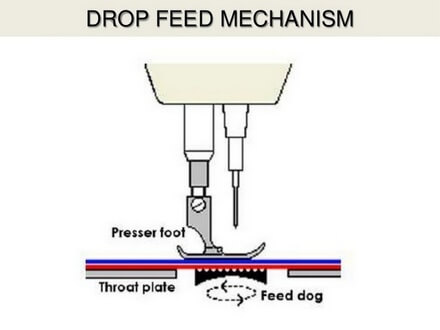Different Parts and Functions of Sewing Machine Feed Mechanism
Sewing Machine Feed Mechanism:
The sewing machine feed mechanism is that which is used for moving the fabrics being stitched from one stitch position to the next. It is one of the most important parts of the sewing machine.

Functions of Sewing Machine Feed Mechanism:
The following are the function of a sewing machine, which totally depends on the feed mechanism.
- Proper seam appearance,
- Proper stitching as required,
- Controlling of SPI ( Stitch per inch),
- Moving forward and backward of sewn fabric,
- Sometimes crease effect is formed according to the design.
Different Parts of Sewing Machine Feed Mechanism:
There are so many types of feed mechanisms are available according to the desired function and machine. But, the common three parts are must whatever the type of feed mechanism is.
The following are the three parts of a sewing machine feed mechanism, which are pointed out below:
- Throat plate or needle plate or feed plate,
- Feed dog,
- Pressure foot.
All the above parts of a sewing machine feed mechanism have explained in the following:
1. Throat plate or needle plate or feed plate:
The part of the bed of the sewing machine has opened for the needle and for feed dog penetrations and which provides localized support to the material. Here, the opening varies in size and shape which is depending on the sewing requirements. This is made of steel and its surface is very smooth. Due to the smooth surface fabrics can be feed easily. It is also called a needle plate or feed plate.
It has one or more slots through which the feed dog can move forward and backward. It has a hole through which the needle can move up and down with the thread. The size of this hole should not exceed more than 30% of the needle size.
2. Feed dog:
A toothed element that acts on the surface of the material is being sewn to move it in a controlled way during stitching. The actions in normally on the lower surface of the material but mechanisms that act on the upper surfaces are also in use. Most of the time, the operative motion is forwards but in specific cases, the motion is reversed. It is the most important part of the feed mechanism. The main function of this part is to move sewn fabric after making individual stitches as a predetermined length.
To prevent the slippage of fabric, the upper parts of the feed do are made toothed. The movement of the feed dog is lateral. Feed dog moves backward and comes upward through the slot of the throat plate which contact with the lower surface of the fabric and moves the fabric forward a step and then descends from the fabric and moves down again below the throat plate. In this way, its lateral movement is completed.
3. Pressure foot:
This is an element that is used to constrain the movement of the material during stitch formation by applying to it an adjustable downward pressure. Pressure foot works in conjunction with the throat plate and feeds dog to achieve controlled movement of the material and correct stitch formation.
Different designs of pressure foot are in use. The most common have a solid or hinged surface that controls the material. It is used to give an adjustable downward pressure on the fabric with spring pressure. So that fabric cannot move up and down with a needle. The lower surface of the pressure foot is very smooth to prevent less friction between fabric and pressure foot.
-Written by
S M Hossen Uzzal
Planning Executive at Modele De Capital Ind. Ltd.
Narayanganj, Dhaka, Bangladesh.
Email: uhossen@gmail.com

Mayedul Islam is a Founder and Editor of Garments Merchandising. He is an Expert in Garments Merchandising. Writing is his passion. He loves to write articles about Apparel, Textile and Garment Washing specially on Merchandising. Mail him at mayedul.islam66@gmail.com


You’ve really imeessprd me with that answer!
Thank you for giving me a better understanding of what a feed dog is.